Parametric Study of the Numerical Model of a Bolted Connection of Steel Structure for Photovoltaic Panels
Abstract
:1. Introduction
2. Materials and Methods
2.1. Numerical Models and Parametrization
2.2. Fatigue Hypotheses
3. Results
3.1. Prestressed Bolt with Nut Connection
3.1.1. Bolt Diameter
3.1.2. Yield Strength of the Bolt
3.1.3. Prestressing Force
3.1.4. Fatigue Analysis Algorithm
3.2. Nutless Bolt Connection
3.2.1. Bolt Diameter
3.2.2. Yield Strength of the Bolt
3.2.3. Coefficient of Friction
3.2.4. Fatigue Analysis Algorithm
4. Discussion
- Both connection models were simplified by following the same assumptions; hence, the introduced simplifications had a similar effect on the final result of the connection fatigue strength;
- The connection with a self-tapping joint (nutless bolt) is similarly durable to the traditional connection with a bolt and a nut; and
- The connection with a self-tapping joint is more modern, faster, and easier to install due to the access required from only one side of the connection.
5. Conclusions
Author Contributions
Funding
Institutional Review Board Statement
Informed Consent Statement
Data Availability Statement
Acknowledgments
Conflicts of Interest
References
- European Commission, Directorate-General for Energy; Rademaekers, K.; Smith, M.; Demurtas, A.; Vega, P.C.T.; Janzow, N.; Zibell, L.; Onne, H.; Karine, P.; Morgan, C.; et al. Study on Energy Prices, Costs and Their Impact on Industry and Households: Final Report; Publications Office: Luxembourg City, Luxembourg, 2020. [Google Scholar]
- European Commission, Caspar Corden, Robert Whiting; Corden, C.; Whiting, R.; Luscombe, D.; Power, O.; Ma, A.; Price, J.; Sharman, M.; Shorthose, J. Study on the Assessment and Management of Environmental Impacts and Risks Resulting from the Exploration and Production of Hy-drocarbons: Final Report; Publications Office of the European Union: Luxembourg City, Luxembourg, 2016. [Google Scholar]
- Eurostat Report. Renewable Energy Statistics. Available online: https://ec.europa.eu/eurostat/statistics-explained/index.php?title=Renewable_energy_statistics#Share_of_renewable_energy_more_than_doubled_between_2004_and_2020 (accessed on 21 April 2022).
- Pacana, A.; Siwiec, D. Model to Predict Quality of Photovoltaic Panels Considering Customers’ Expectations. Energies 2022, 15, 1101. [Google Scholar] [CrossRef]
- Hajjaj, S.S.H.; Aqeel, A.A.K.A.; Sultan, M.T.H.; Shahar, F.S.; Shah, A.U.M. Review of Recent Efforts in Cooling Photovoltaic Panels (PVs) for Enhanced Performance and Better Impact on the Environment. Nanomaterials 2022, 12, 1664. [Google Scholar] [CrossRef] [PubMed]
- Fijałkowska, A.; Waksmundzka, K.; Chmiel, J. Assessment of the Effectiveness of Photovoltaic Panels at Public Transport Stops: 3D Spatial Analysis as a Tool to Strengthen Decision Making. Energies 2022, 15, 1230. [Google Scholar] [CrossRef]
- Cabeza, L.F.; Borri, E.; Prieto, C. Bibliometric Map on Corrosion in Concentrating Solar Power Plants. Energies 2022, 15, 2619. [Google Scholar] [CrossRef]
- Gao, X.; Wei, S.; Xia, C.; Li, Y. Flexible Operation of Concentrating Solar Power Plant with Thermal Energy Storage Based on a Coordinated Control Strategy. Energies 2022, 15, 4929. [Google Scholar] [CrossRef]
- Uematsu, Y.; Yambe, T.; Yamamoto, A. Wind Loading of Photovoltaic Panels Installed on Hip Roofs of Rectangular and L-Shaped Low-Rise Buildings. Wind 2022, 2, 288–304. [Google Scholar] [CrossRef]
- Uematsu, Y.; Yambe, T.; Yamamoto, A. Application of a Numerical Simulation to the Estimation of Wind Loads on Photovoltaic Panels Installed Parallel to Sloped Roofs of Residential Houses. Wind 2022, 2, 129–149. [Google Scholar] [CrossRef]
- Rosmanit, M.; Parenica, P.; Sucharda, O.; Lehner, P. Physical Tests of Alternative Connections of Different High Roof Purlins Regarding Upward Loading. Buildings 2021, 11, 512. [Google Scholar] [CrossRef]
- Taranu, G.; Toma, I.-O. Experimental Investigation and Numerical Simulation of C-Shape Thin-Walled Steel Profile Joints. Buildings 2021, 11, 636. [Google Scholar] [CrossRef]
- Szewczak, I.; Rozylo, P.; Rzeszut, K. Influence of Mechanical Properties of Steel and CFRP Tapes on the Effectiveness of Strengthening Thin-Walled Beams. Materials 2021, 14, 2388. [Google Scholar] [CrossRef] [PubMed]
- Szewczak, I.; Rozylo, P.; Snela, M.; Rzeszut, K. Impact of Adhesive Layer Thickness on the Behavior of Reinforcing Thin-Walled Sigma-Type Steel Beams with CFRP Tapes. Materials 2022, 15, 1250. [Google Scholar] [CrossRef] [PubMed]
- Ciesielczyk, K.; Studziński, R. Experimental and numerical investigation of stabilization of thin-walled Z-beams by sandwich panels. J. Constr. Steel Res. 2017, 133, 77–83. [Google Scholar] [CrossRef]
- Gosowski, B. Spatial stability of braced thin-walled members of steel structures. J. Constr. Steel Res. 2003, 5, 839–865. [Google Scholar] [CrossRef]
- Ciesielczyk, K.; Studziński, R. Experimental Investigation of the Failure Scenario of Various Connection Types between Thin-Walled Beam and Sandwich Panel. Materials 2022, 15, 6277. [Google Scholar] [CrossRef] [PubMed]
- Wierszycki, M.; Kąkol, W.; Łodygowski, T. The screw loosening and fatigue analyses of three dimensional dental implant model. In Proceedings of the Abaqus Users’ Conference, Boston, MA, USA, 23–25 May 2006. [Google Scholar]
- Szajek, K.; Wierszycki, M. Numerical verification of two-component dental implant in the context of fatigue life for various load cases. Acta Bioeng. Biomech. 2016, 18, 103–113. [Google Scholar]
- Szajek, K.; Wierszycki, M.; Topoliński, T.; Łodygowski, T. Experimental verification of the two component implant optimization results in context of fatigue life. Eksploat. Niezawod.—Mainten. Reliabil. 2017, 19, 166–171. [Google Scholar] [CrossRef]
- Belardi, V.G.; Fanelli, P.; Vivio, F. Analysis of multi-bolt composite joints with a user-defined finite element for the evaluation of load distribution and secondary bending. Comp. Part B Eng. 2021, 227, 109378. [Google Scholar] [CrossRef]
- Sharos, P.A.; McCarthy, C.T. Novel finite element for near real-time design decisions in multi-fastener composite bolted joints under various loading rates. Comp. Struct. 2020, 240, 112005. [Google Scholar] [CrossRef]
- Nassiraei, H.; Rezadoost, P. Stress concentration factors in tubular T/Y-joints strengthened with FRP subjected to compressive load in offshore structures. Int. J. Fatig. 2020, 140, 105719. [Google Scholar] [CrossRef]
- Nassiraei, H.; Rezadoost, P. Stress concentration factors in tubular X-connections retrofitted with FRP under compressive load. Ocean Eng. 2021, 229, 108562. [Google Scholar] [CrossRef]
- Dietsch, P.; Brandner, R. Self-tapping screws and threaded rods as reinforcement for structural timber elements—A state-of-the-art report, Construct. Build. Mater. 2015, 97, 78–89. [Google Scholar] [CrossRef]
- Bedon, C.; Fragiacomo, M. Numerical analysis of timber-to-timber joints and composite beams with inclined self-tapping screws. Comp. Struct. 2019, 207, 13–28. [Google Scholar] [CrossRef]
- ABAQUS FEA. Available online: https://www.3ds.com/products-services/simulia/products/abaqus (accessed on 2 September 2022).
- Brown, M.W.; Miller, K.J. A theory of fatigue under multiaxial strain conditions. Proc. Inst. Mech. Eng. 1973, 187, 745–755. [Google Scholar] [CrossRef]
- Morrow, J. Fatigue Design Handbook. Soc. Automot. Eng. 1968, 3, 21–29. [Google Scholar]
- Smith, K.N.; Watson, P.; Topper, T.H. A stress-strain function for the fatigue of metals. J. Mater. 1970, 5, 767–778. [Google Scholar]

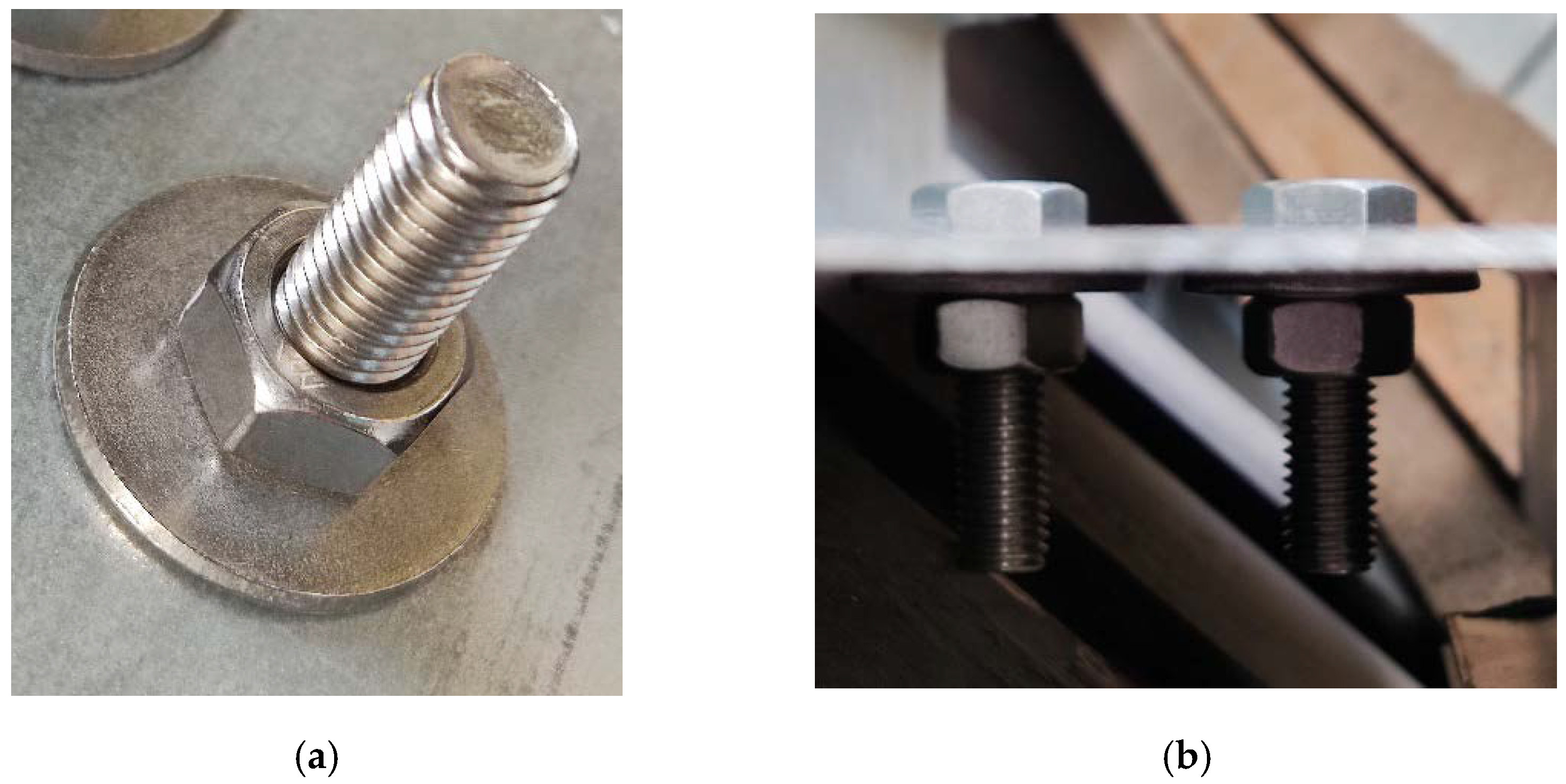

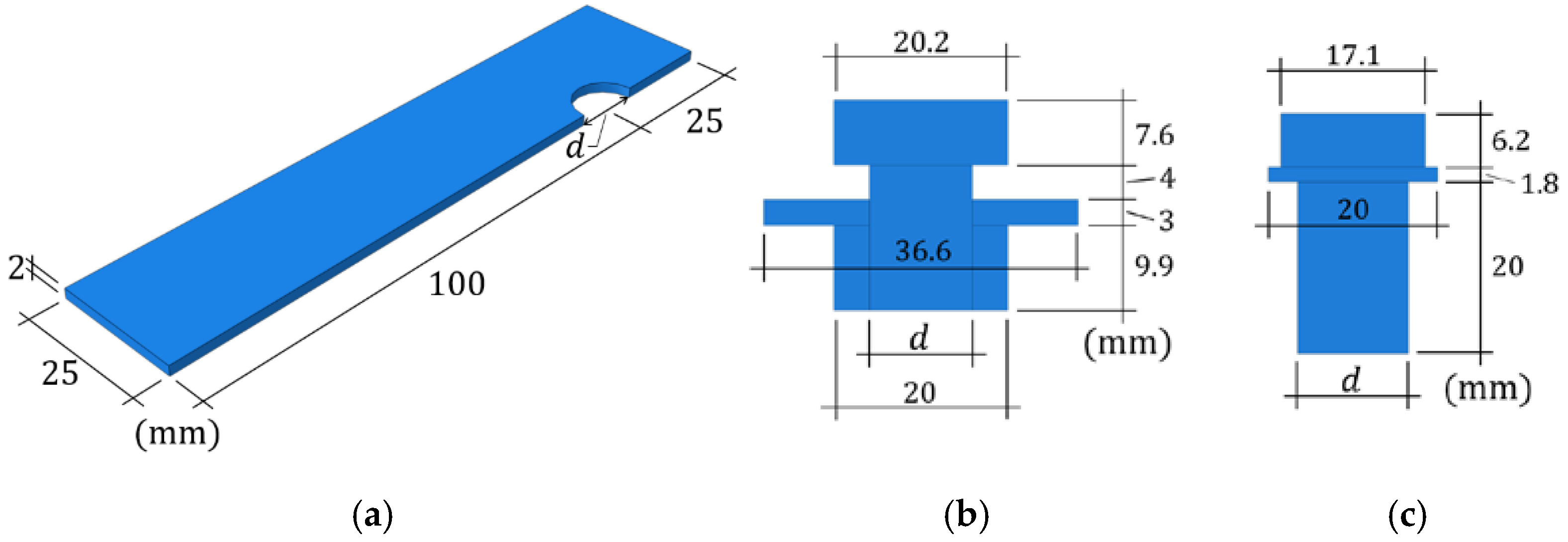
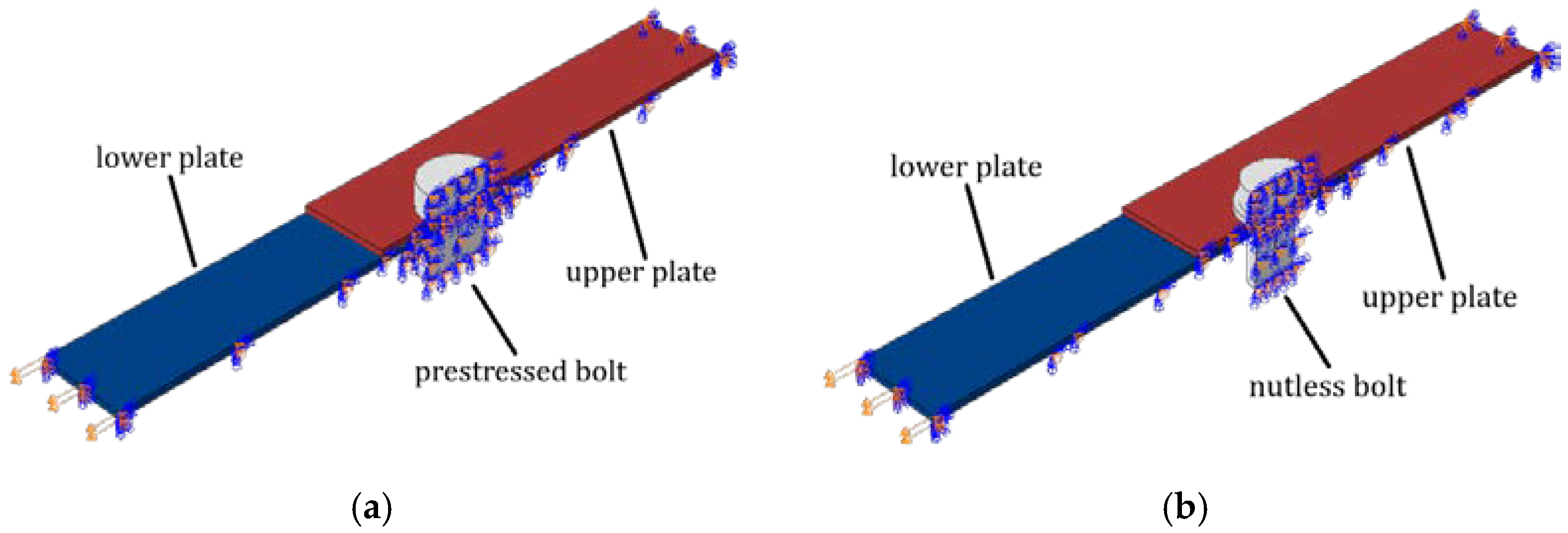
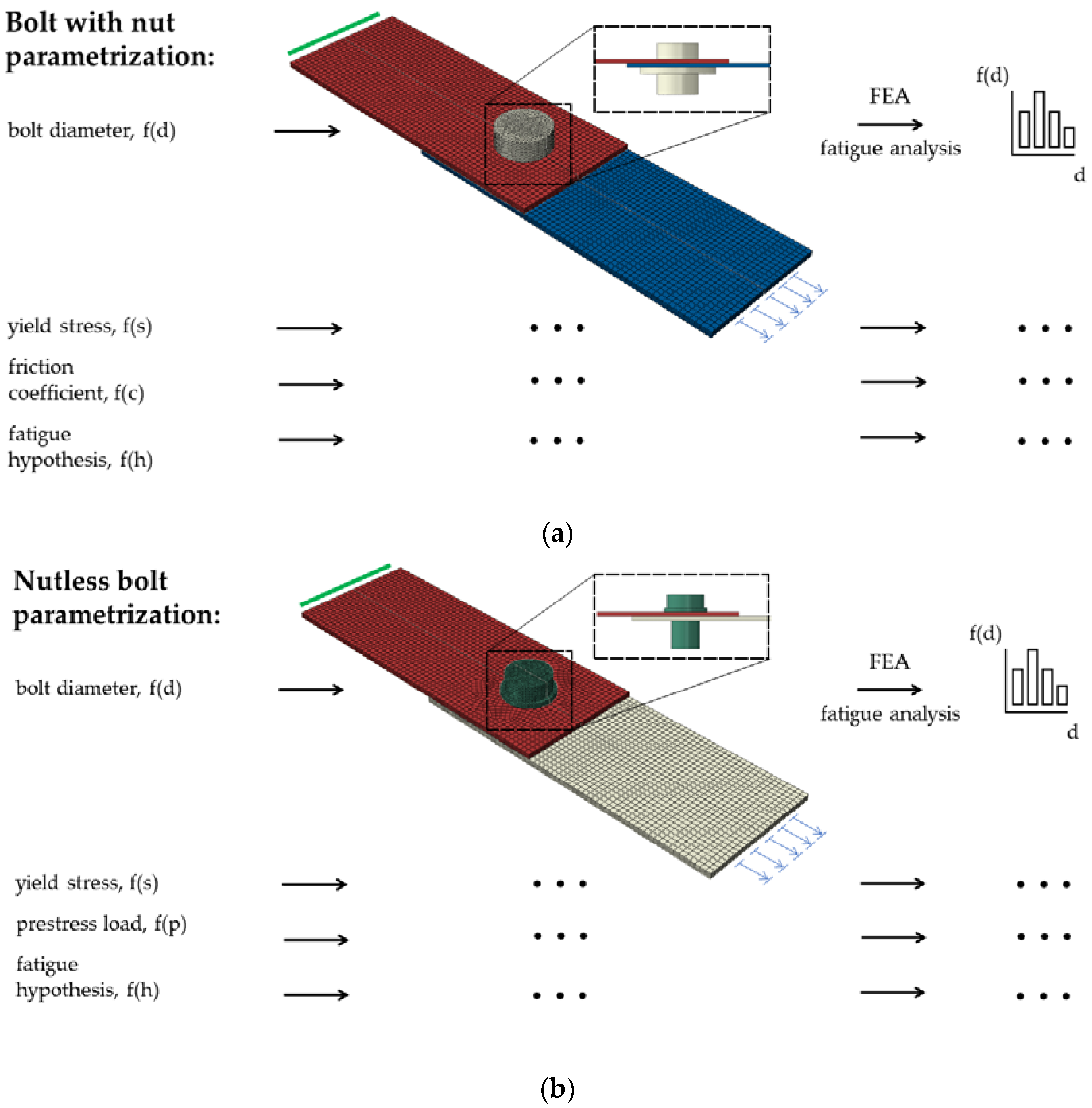



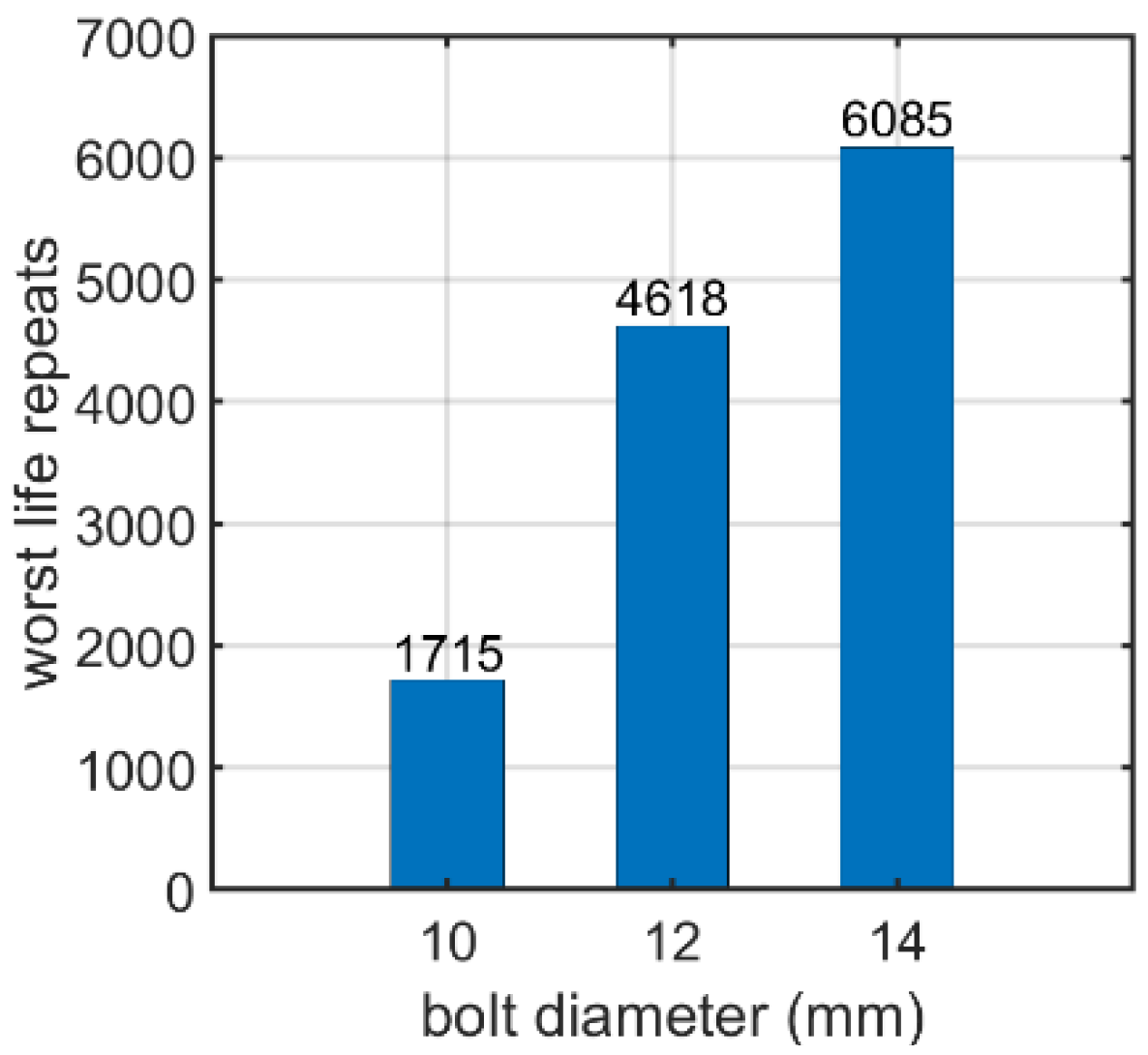
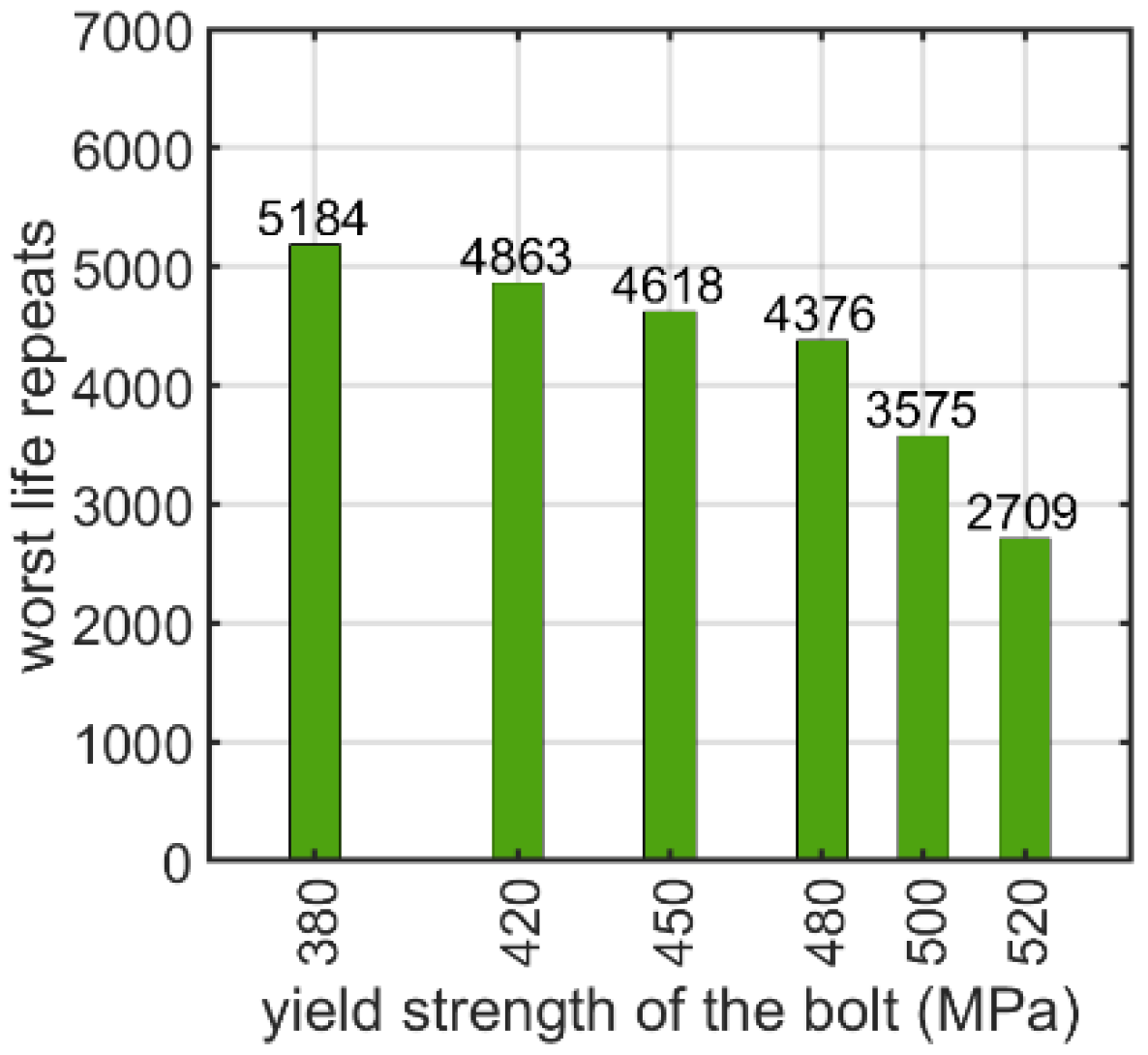


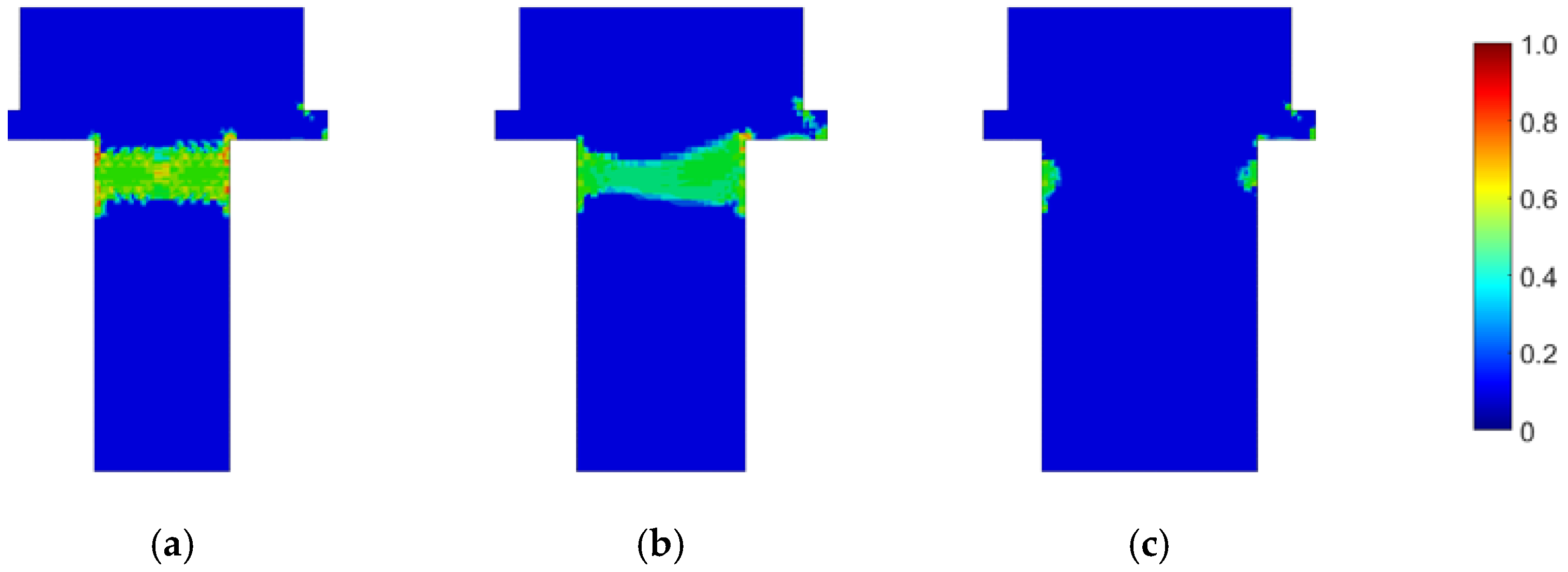


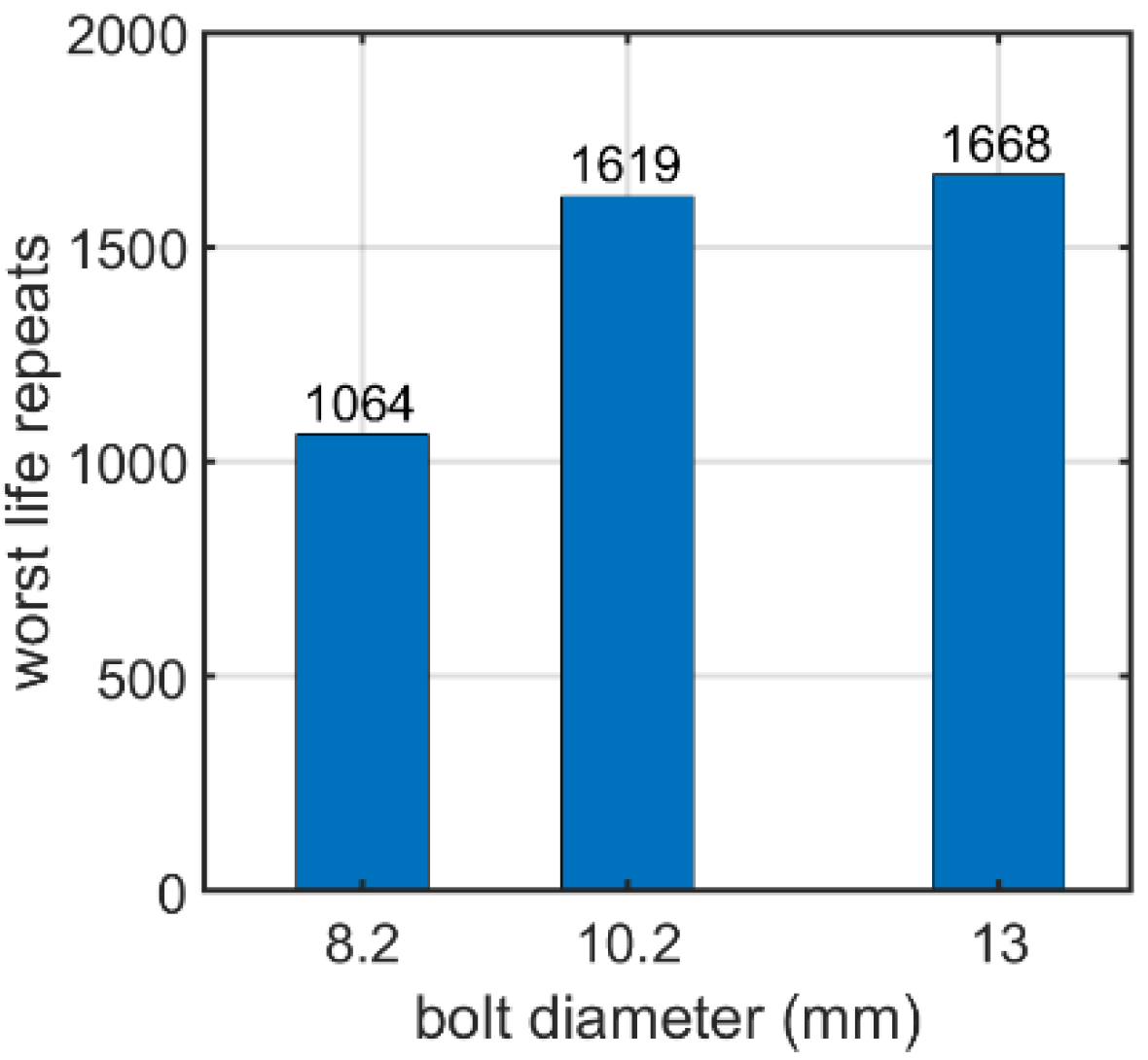
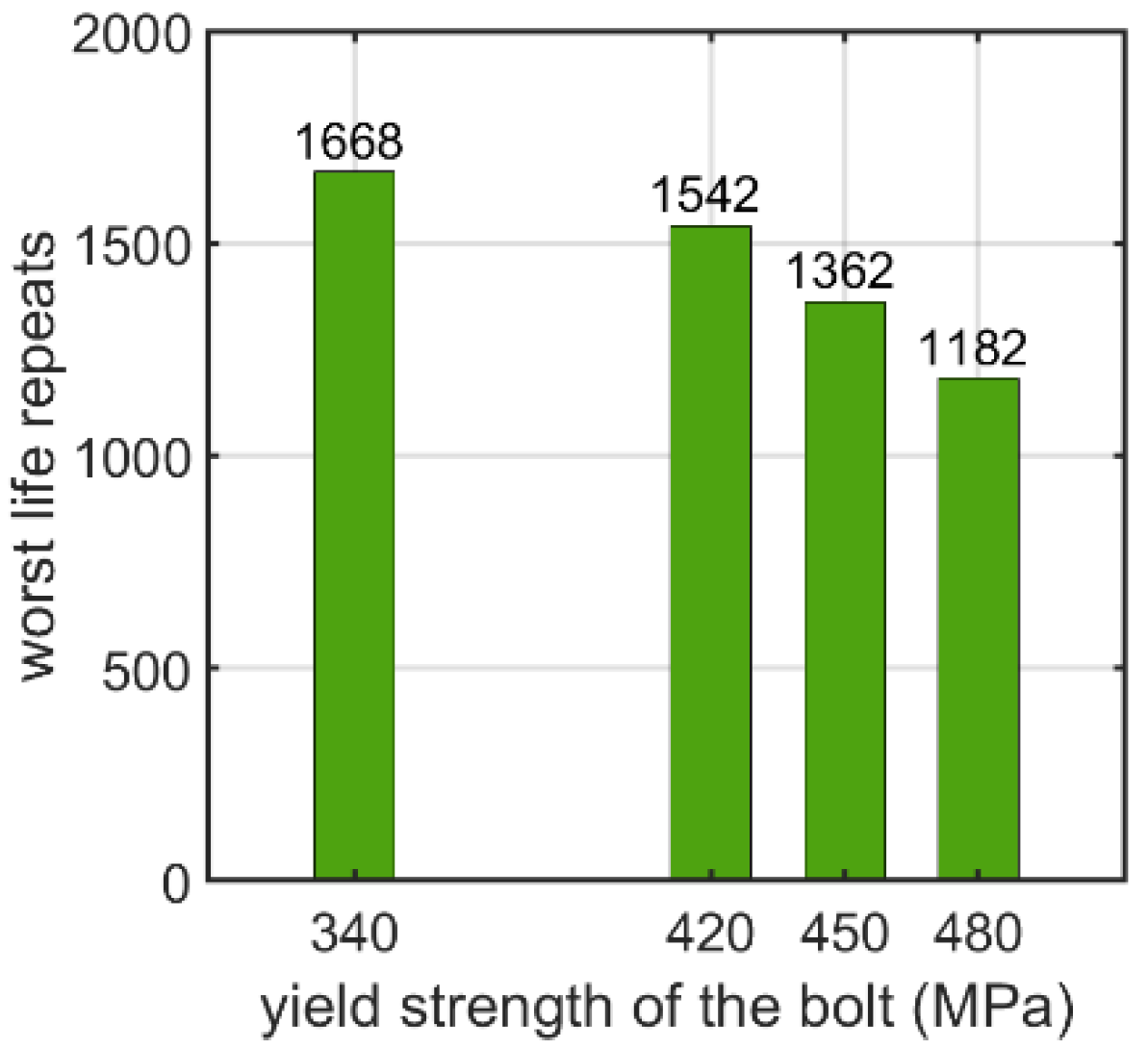


| Parameter | Bolt with Nut | Nutless Bolt |
|---|---|---|
| Bolt diameter (mm) | 12.0 | 13.2 |
| Yield strength of the bolt (MPa) | 450 | 340 |
| Coefficient of friction between plates and bolt head (–) | – | 0.10 |
| Prestressing force (kN) | 27 | – |
| Fatigue hypothesis | Brown–Miller–Morrow criterion | Brown–Miller–Morrow criterion |
Publisher’s Note: MDPI stays neutral with regard to jurisdictional claims in published maps and institutional affiliations. |
© 2022 by the authors. Licensee MDPI, Basel, Switzerland. This article is an open access article distributed under the terms and conditions of the Creative Commons Attribution (CC BY) license (https://creativecommons.org/licenses/by/4.0/).
Share and Cite
Mrówczyński, D.; Gajewski, T.; Garbowski, T. Parametric Study of the Numerical Model of a Bolted Connection of Steel Structure for Photovoltaic Panels. Materials 2022, 15, 6794. https://doi.org/10.3390/ma15196794
Mrówczyński D, Gajewski T, Garbowski T. Parametric Study of the Numerical Model of a Bolted Connection of Steel Structure for Photovoltaic Panels. Materials. 2022; 15(19):6794. https://doi.org/10.3390/ma15196794
Chicago/Turabian StyleMrówczyński, Damian, Tomasz Gajewski, and Tomasz Garbowski. 2022. "Parametric Study of the Numerical Model of a Bolted Connection of Steel Structure for Photovoltaic Panels" Materials 15, no. 19: 6794. https://doi.org/10.3390/ma15196794








